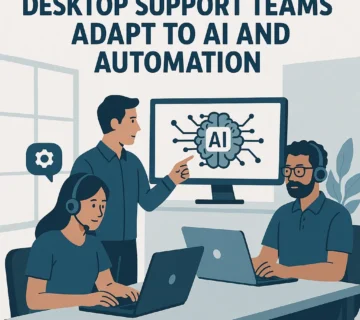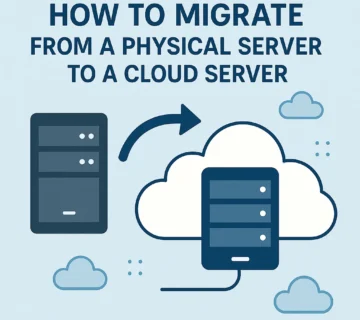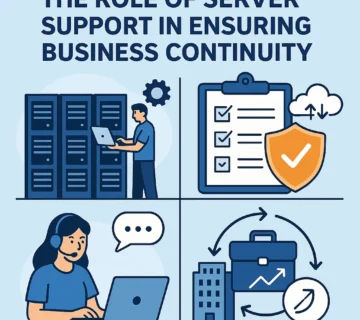2025 Server Support Trends: Automation, AI & Zero Downtime

As we enter 2025, the server support landscape is transforming faster than ever. Businesses are becoming increasingly dependent on real-time applications, cloud services, and data-driven operations. This means that servers—the backbone of every digital system—must operate flawlessly, securely, and without interruption.
The traditional “break-fix” model of server support is officially outdated. Today, companies demand zero downtime, seamless performance, and instant recovery from failures. To meet these expectations, IT teams are turning to automation, artificial intelligence (AI), and next-generation infrastructure technologies.
This comprehensive guide explores the most important server support trends defining 2025 and offers insights into how businesses can modernize their server environments for a high-availability future.
1. The New Era of Proactive & Predictive Server Support
In the past, IT teams waited for servers to fail before taking action. But with 24/7 operations and remote global workforces, reactive support is no longer acceptable.
In 2025, proactive and predictive support models have become the standard.
Key Elements of Proactive Server Support
-
Continuous monitoring of CPU, memory, disk, network, and application performance
-
Early detection of abnormal patterns through behavior analytics
-
Predictive maintenance that forecasts hardware or software failures
-
Automated remediation triggered by predefined rules or AI
By analyzing historical data and real-time performance metrics, AI models can identify early warning signs—slow memory leaks, unusual I/O activity, overheating hardware, failing disks, and more.
This reduces costly downtime and keeps systems performing at peak levels.
2. Automation Takes Center Stage
IT leaders consistently rate automation as the #1 factor improving reliability, reducing labor costs, and accelerating server management.
Automation in 2025 covers every major aspect of server support:
✔ Automated Patching & Firmware Updates
Servers can now automatically apply:
-
OS patches
-
Security updates
-
Firmware upgrades
-
Software version pushes
And then run validation tests without downtime.
✔ Automated Backups & Disaster Recovery
Advanced DR platforms can:
-
Create snapshots
-
Replicate servers across regions
-
Trigger automatic failovers
-
Restore systems instantly
These automated solutions ensure data integrity and rapid recovery after disasters.
✔ Self-Healing Infrastructure
Automated scripts and AI logic help servers fix themselves by:
-
Restarting stuck services
-
Rebooting failed VMs
-
Releasing locked resources
-
Cleaning logs
-
Balancing workloads
This reduces manual troubleshooting and ensures consistent uptime.
✔ Auto-Scaling & Dynamic Workload Balancing
Based on real-time demand:
-
Cloud servers scale up or down
-
Resources are allocated intelligently
-
Network routing adapts automatically
This provides optimal performance while reducing operational costs.
3. AI-Powered Server Support Becomes the New Standard
Artificial intelligence has moved from a “nice-to-have” to an essential component of modern server support.
The rise of AIOps (Artificial Intelligence for IT Operations) is transforming the way organizations detect, analyze, and resolve issues.
Key AI Advancements in 2025
1. Predictive Failure Detection
AI identifies:
-
Hardware failure patterns
-
Failing disks or components
-
Software crash indicators
-
Memory consumption anomalies
This allows teams to fix issues before they escalate.
2. Intelligent Alert Filtering
AI reduces alert noise by:
-
Eliminating false positives
-
Grouping related alerts
-
Ranking incidents by severity
This helps technicians focus on real issues.
3. Automated Troubleshooting Assistance
AI tools can:
-
Analyze logs instantly
-
Suggest fixes
-
Provide root-cause reports
-
Recommend configuration improvements
This accelerates response time and reduces human errors.
4. Smart Resource Optimization
AI analyzes usage trends to:
-
Optimize CPU and memory usage
-
Improve storage allocation
-
Enhance load balancing
-
Refine auto-scaling decisions
Machines are now capable of learning patterns and continuously improving server performance.
4. Zero Downtime Becomes Mandatory
In 2025, users expect:
-
No service interruptions
-
No maintenance windows
-
No scheduled outages
This expectation is redefining how IT teams manage infrastructure.
Architectures Powering Zero Downtime
✔ High-Availability (HA) Clusters
Servers run in redundant configurations so if one fails, another takes over seamlessly.
✔ Geo-Redundant Hosting
Workloads are distributed across:
-
Multiple locations
-
Multiple cloud zones
-
Multiple data centers
This eliminates single points of failure.
✔ Continuous Deployment & Rolling Updates
Technologies like Kubernetes and service meshes allow updates with:
-
No downtime
-
No user impact
-
No application restarts
✔ Load Balancers & Traffic Shaping
Traffic is intelligently routed based on:
-
Server health
-
Region
-
Latency
-
Resource availability
Businesses now treat downtime as unacceptable because the cost—in lost revenue and trust—is simply too high.
5. Security-Driven Server Support (Zero Trust + AI Security)
Cybersecurity threats in 2025 are more sophisticated, automated, and AI-enhanced. As a result, security is now embedded deeply into server support operations.
Key Security Measures Integrated Into Server Support
-
Zero Trust Architecture (ZTA)
-
Automated vulnerability scanning
-
Continuous server hardening
-
AI-based threat detection
-
Encrypted communications & backups
-
Multi-factor authentication across all systems
-
Real-time SIEM integration for monitoring
Security is no longer a separate function—it is part of the core server management process.
6. Hybrid & Multi-Cloud Environments Dominate 2025
Organizations are embracing:
-
On-prem servers
-
Private cloud
-
Public cloud
-
Multi-cloud architectures
-
Containers (Docker)
-
Kubernetes orchestration
This shift allows:
-
Enhanced redundancy
-
Improved flexibility
-
Greater cost control
-
Faster deployment cycles
But it also adds complexity. That’s why smart orchestration tools, automation engines, and AI-driven optimization are essential to managing modern hybrid infrastructures.
7. Unified Server Management Platforms
In 2025, more organizations are deploying single-pane-of-glass server management tools that consolidate:
-
Monitoring
-
Automation
-
Patch management
-
Logging
-
Backups
-
Security tools
-
Cloud orchestration
-
Compliance reporting
This unified approach allows IT teams to act quickly and decisively, improving both performance and reliability.
8. DevOps & SRE Practices Continue to Shape Server Reliability
DevOps and Site Reliability Engineering (SRE) are playing an even larger role in server support.
Benefits of DevOps & SRE in 2025
-
Reduced downtime
-
Faster deployments
-
Higher-quality releases
-
Predictable incident response
-
Infrastructure-as-Code (IaC) consistency
-
Blameless post-incident reviews
Organizations that embrace these principles achieve higher levels of reliability and scalability.
Conclusion
The year 2025 marks a pivotal moment in the evolution of server support. The convergence of automation, AI, and advanced infrastructure technologies is enabling businesses to achieve levels of uptime and performance once thought impossible.
The shift toward zero downtime, predictive support, and AI-driven operations isn’t just a trend—it’s a new standard.
Organizations that embrace these innovations will gain:
-
Lower operational costs
-
Faster recovery times
-
Greater flexibility
-
Improved user satisfaction
-
Stronger security
-
Long-term competitive advantage
Now is the time for businesses to modernize their server environments and prepare for a future where flawless performance is expected.
Frequently Asked Questions (FAQ)
1. What are the biggest server support trends in 2025?
The top trends include AI-powered server management, automation, predictive maintenance, self-healing infrastructure, zero-downtime architecture, and hybrid cloud operations.
2. How does automation improve server uptime?
Automation eliminates human errors, applies patches instantly, manages backups, triggers failovers, and performs routine maintenance—significantly reducing downtime.
3. What is AIOps and why is it important?
AIOps uses artificial intelligence to enhance IT operations by detecting anomalies, predicting failures, and automating incident response. It increases reliability and reduces manual workload.
4. What does zero downtime mean?
Zero downtime means servers remain online 24/7 without interruption—even during updates, maintenance, or unexpected failures—thanks to redundancy and automated failover.
5. How does predictive maintenance help server health?
Predictive maintenance uses data analytics and machine learning to detect issues before they occur, preventing outages and extending hardware lifespan.
6. Can AI completely replace human IT technicians?
No. AI automates repetitive tasks and assists with diagnostics, but humans are still essential for strategic planning, architecture design, and complex troubleshooting.
7. Why is hybrid cloud popular in 2025?
Hybrid cloud provides flexibility, scalability, cost control, and redundancy. It allows businesses to balance workloads across on-prem and cloud environments.
8. How do self-healing servers work?
Self-healing systems automatically detect failures, restart services, rebalance workloads, or switch to redundant nodes without human intervention.
9. How does AI improve server security?
AI identifies unusual behavior, detects intrusion attempts, blocks malicious activities, and predicts potential vulnerabilities—enhancing overall security.
10. What steps can a business take to achieve zero downtime?
To achieve zero downtime, businesses should implement:
-
High-availability clusters
-
Load balancing
-
Automated failovers
-
Continuous deployment
-
Strong security
-
Redundant infrastructure







No comment